Shocking Deals: Your Guide to the Best TENS Machines
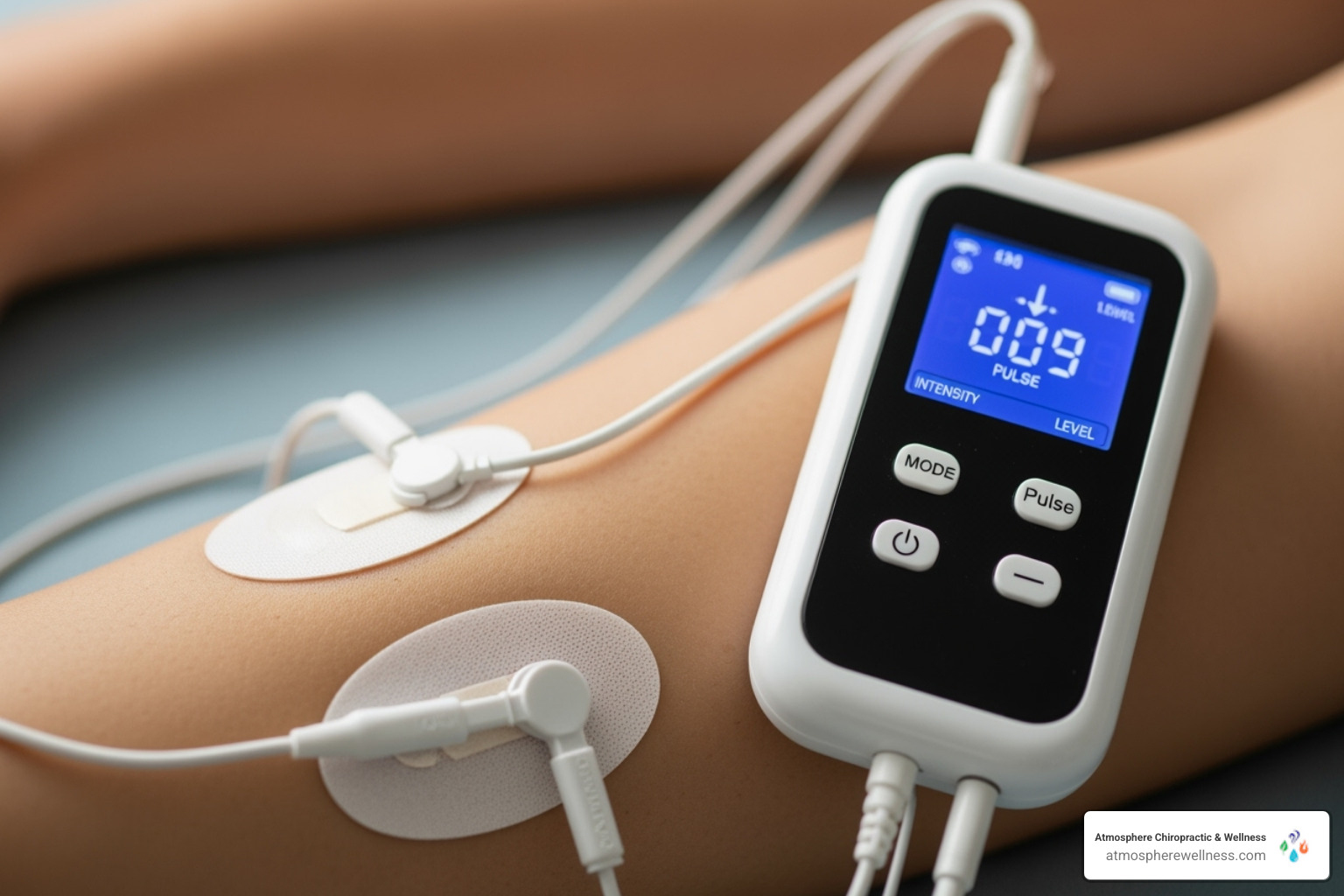
Why TENS Machines Are Revolutionizing Drug-Free Pain Relief
A tens machine (Transcutaneous Electrical Nerve Stimulation) is a small, portable device that uses mild electrical currents to reduce pain naturally. These battery-powered units send gentle electrical pulses through electrode pads on your skin, offering a non-invasive alternative to pain medications.
Quick TENS Machine Guide:
- How it works: Blocks pain signals and triggers endorphins (natural painkillers).
- Best for: Chronic pain, arthritis, back pain, sports injuries, period pain.
- Safety: Safe for most adults but not for people with pacemakers or pregnant women (on abdomen/back).
- Cost: $30-$200.
TENS therapy operates on two principles: the "gate control theory," where it blocks pain signals from reaching the brain, and by triggering the release of endorphins. Research supports its use for conditions from arthritis to sports injuries, with many users feeling relief for hours after a session.
I'm Dr. Gannon Ward, and since 2008, I've helped patients manage pain naturally. In my practice, I often recommend tens machine therapy as part of a comprehensive, drug-free pain management plan.
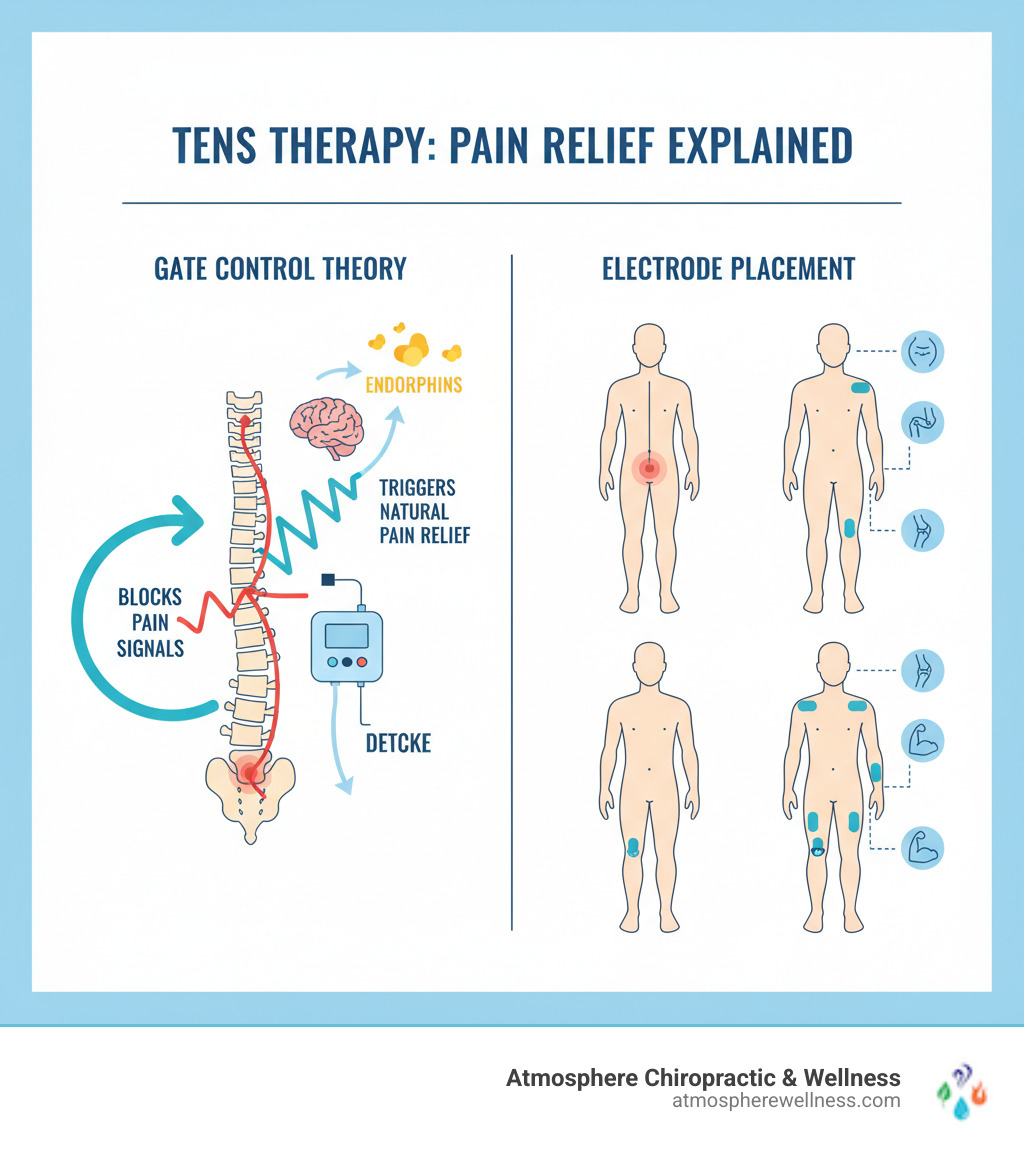
Simple guide to tens machine terms:
Understanding How a TENS Machine Provides Pain Relief
A tens machine provides relief by interacting with your nervous system in two key ways. First, it uses the gate control theory. The device sends gentle electrical pulses that stimulate sensory nerves, effectively closing a "gate" in your spinal cord that prevents pain signals from reaching the brain.
Second, TENS therapy triggers the release of endorphins, your body's natural painkillers. These chemicals are powerful and help reduce pain perception. Instead of pain, you feel a comfortable tingling sensation. This non-painful current overrides the discomfort, providing a soothing effect.
For a comprehensive approach to managing your discomfort, explore our Pain Relief Therapy services to see how TENS can fit into your wellness plan.
How TENS Works
A tens machine delivers controlled electrical pulses via electrode pads on the skin, targeting sensory nerves. You can customize these signals for optimal relief.
- Adjustable intensity allows you to find a level that is strong but comfortable.
- Pulse width controls the duration of each pulse; wider pulses penetrate deeper.
- Frequency (Hz), or pulses per second, is also key. High frequencies (90-130 Hz) provide fast relief via the gate control theory. Low frequencies (1-5 Hz) are better for stimulating long-lasting endorphin release.
What Does TENS Feel Like?
First-time users often wonder what TENS feels like. It's not painful; most people find the sensation pleasant. You'll feel a gentle buzzing sensation, tingling, or soft prickling under the pads. The goal is to set the intensity to a level that feels strong but comfortable. It should never hurt or cause muscle twitching. Many find the sensation soothing and relaxing as it replaces the feeling of pain.
What Types of Pain Can a TENS Machine Help With?
A tens machine is highly versatile, offering relief for various pain types. It's effective for musculoskeletal pain (affecting muscles, bones, and joints) and some nerve-related pain. TENS can be used for both chronic pain, which is long-lasting, and acute pain, which is sudden and often follows an injury. It provides a valuable drug-free option for managing discomfort.
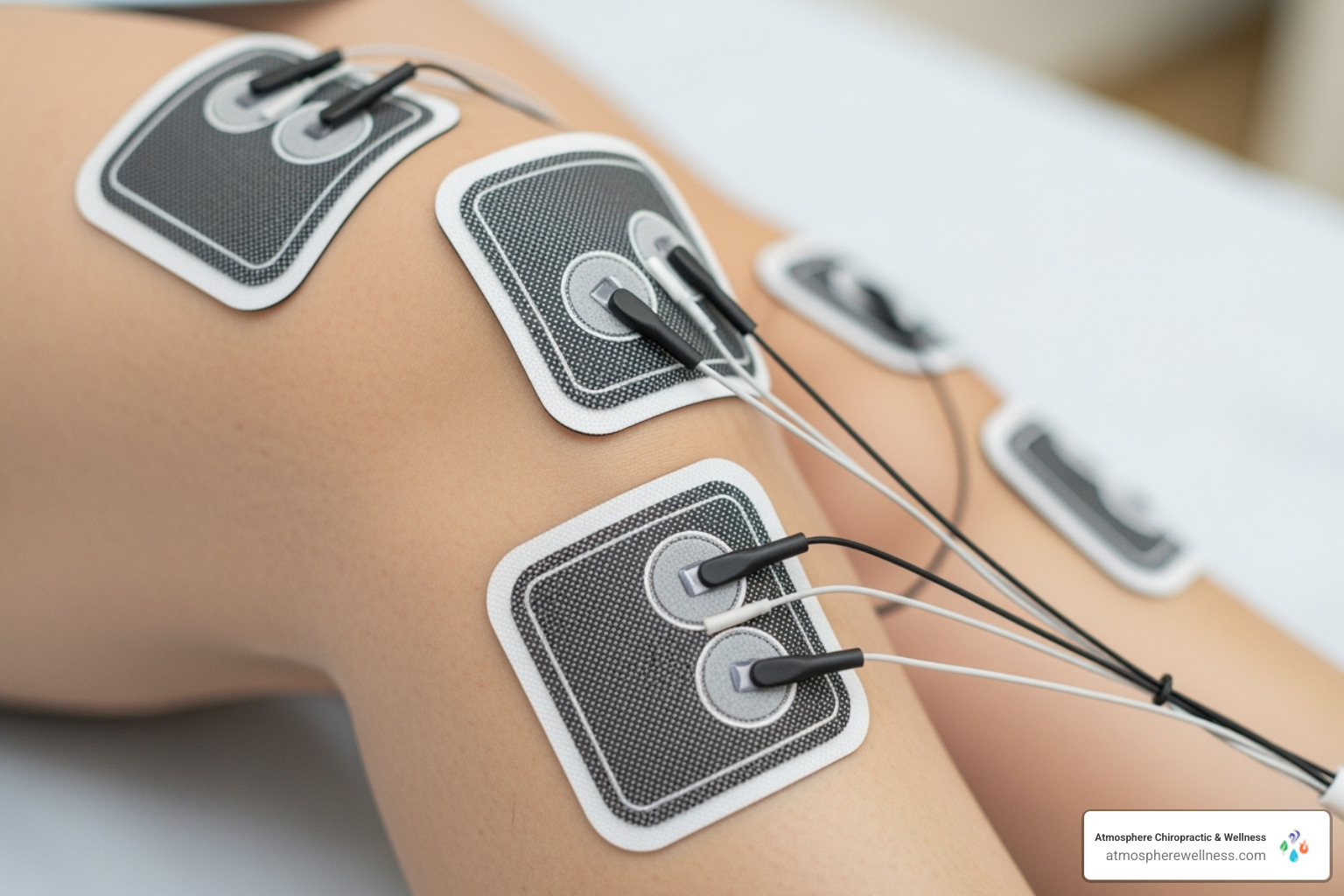
Chronic Conditions
A tens machine can be a vital tool for managing chronic pain, helping patients in Lehi regain control over their lives.
- Arthritis: For both osteoarthritis and rheumatoid arthritis, TENS can block joint pain signals and may improve mobility.
- Fibromyalgia: TENS offers a gentle, non-drug option for the widespread pain and tenderness of fibromyalgia, a condition that can be difficult to treat with medication.
- Back pain: A tens machine provides significant relief for lower back aches and neck tension, working well alongside treatments like chiropractic care. Our Back Pain Relief Lehi plan often includes TENS.
- Endometriosis: TENS provides a non-invasive, controllable way to manage the chronic pelvic pain associated with endometriosis and other similar conditions.
Acute Pain and Injuries
A tens machine is an excellent portable companion for sudden, acute pain.
- Sports injuries: TENS provides immediate relief for sprains and strains, making it a great tool for athletes. We often use it in our Injury Recovery Therapy programs to speed up a return to activity.
- Post-operative pain: Using TENS after surgery can reduce the need for pain medication, leading to fewer side effects and a smoother recovery.
- Labor pain: TENS is a popular option during childbirth, giving women more control over pain management and potentially reducing the need for stronger medications.
- Period pain: A tens machine is highly effective for menstrual cramps, backed by strong evidence that TENS helps with period pain, offering a drug-free way to manage monthly discomfort.
Your Guide to Choosing the Best TENS Machine
Choosing the right tens machine can seem daunting, but it's straightforward if you know what to look for. Most units are compact, portable, and available without a prescription. When selecting a device, consider your lifestyle, pain patterns, and how you plan to use it. Think about whether you need a discreet unit for work, multiple channels for different pain areas, or simple versus advanced controls.
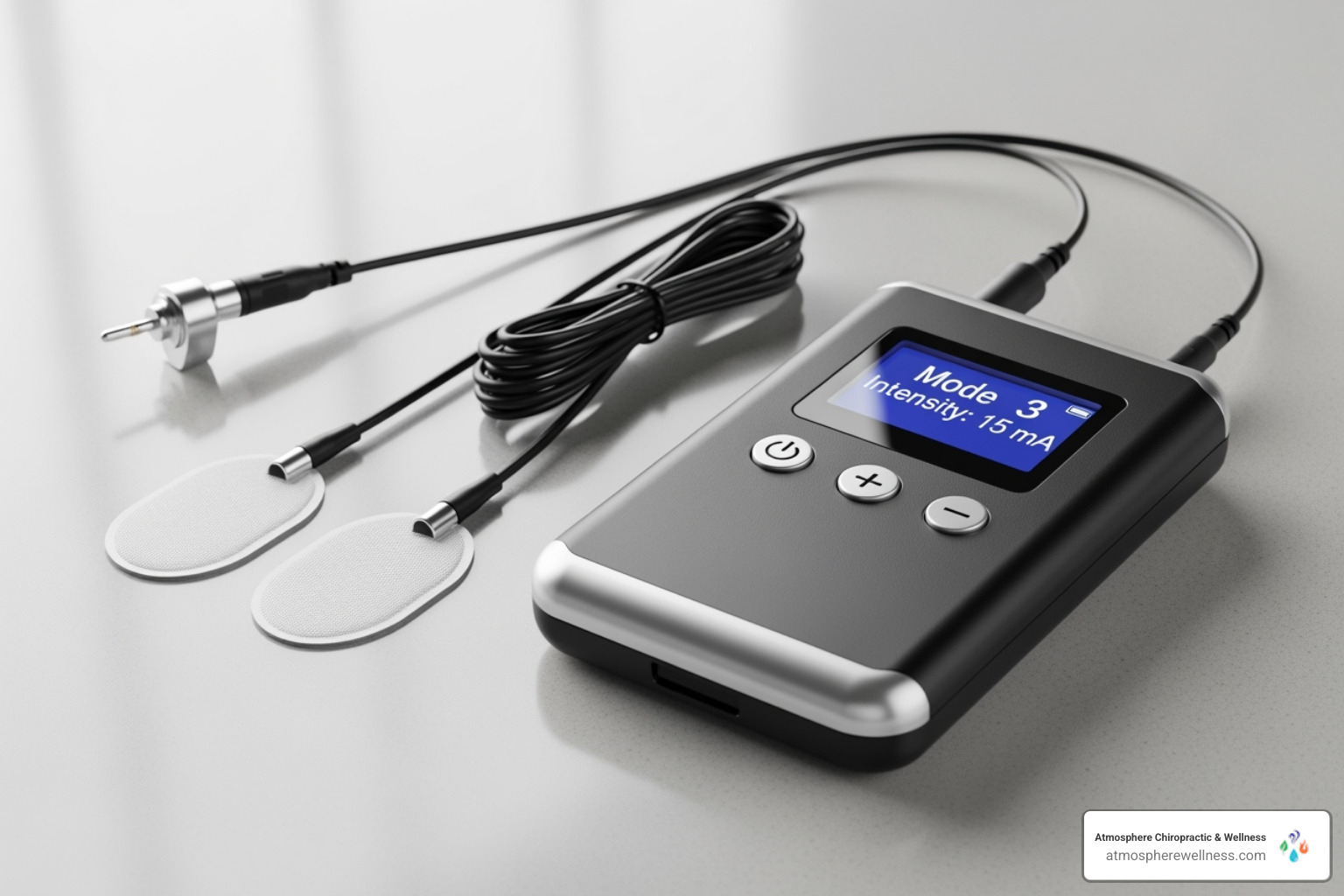
Key Features to Consider When Buying a tens machine
Understanding these key features will help you choose the best tens machine for your needs:
- Channels: Dual channel units (4 pads) are most common, great for one or two pain areas. Quad channel units (8 pads) are better for multiple or widespread pain sites.
- Power Source: Rechargeable (USB) units are convenient and eco-friendly. Disposable battery models are good for travel without access to charging.
- Intensity Levels: Look for at least 20 levels to ensure you can find a setting that is strong but comfortable for different body parts.
- Pre-set Programs: These automated modes are great for beginners, offering custom settings for specific conditions like back pain or arthritis.
- Portability and Size: Choose a small, lightweight unit that can be clipped to a belt or put in a pocket for on-the-go relief.
- Electrode Pad Quality: High-quality, reusable pads with good adhesive are essential for effective treatment and are more cost-effective over time.
- Regulatory Approval: Ensure the device is approved by a health authority to guarantee safety and performance.
Understanding Different Stimulation Modes
Most tens machine units offer several stimulation modes:
- Conventional (High-Frequency) TENS: Operates at 90-130 Hz for fast-acting relief via the gate control theory. Ideal for acute pain.
- Acupuncture-like (Low-Frequency) TENS: Uses 1-5 Hz to trigger endorphin release for longer-lasting relief. The sensation is more intense.
- Burst Mode: Delivers pulses in bursts, combining high and low-frequency benefits. It's effective for deep, chronic pain.
- Modulation Mode: Automatically varies the stimulation to prevent your nerves from adapting, which maintains effectiveness over time.
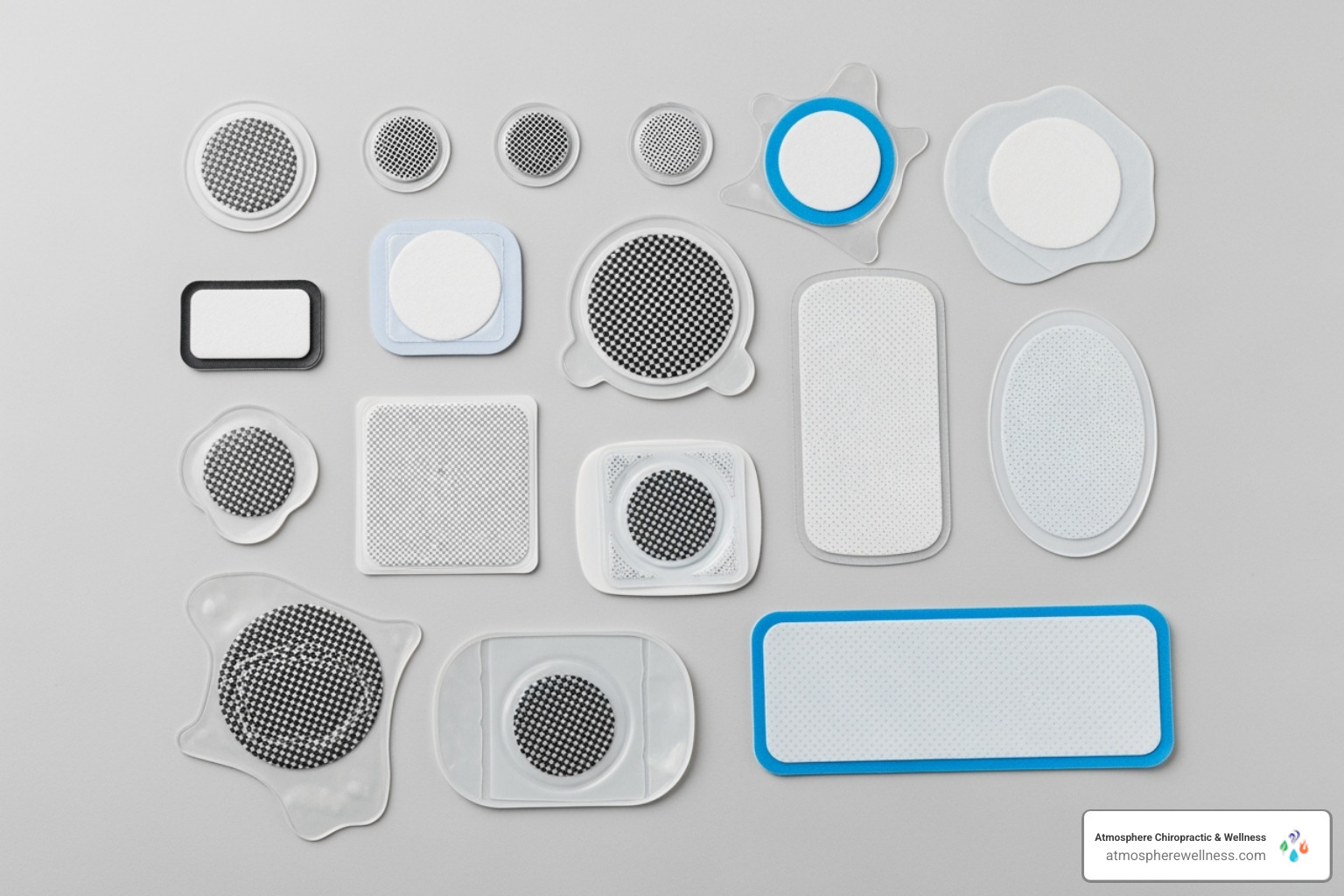
Experimenting with these modes, preferably with professional guidance, will help you find what works best for your specific pain.
Safe and Effective Use: Best Practices and Precautions
To use your tens machine safely and effectively, it's best to start with professional advice from a healthcare provider or physical therapist. They can provide personalized guidance for your specific condition.
Side effects are rare and usually limited to mild skin redness or irritation under the pads. If irritation persists, take a break and consult your provider.

Best Practices for Using Your tens machine
- Electrode Placement: This is crucial for success. Place pads on either side of the pain, at least an inch apart. Use the included charts for guidance, but experiment safely to find the best spots for you.
- Start with Low Intensity: Always begin at the lowest setting and slowly increase it until you feel a strong but comfortable tingling. It should never be painful or cause muscle spasms.
- Skin Preparation: Apply pads to clean, dry skin, free of any lotions or oils. This ensures good connection and prevents irritation.
- Session Length and Frequency: A typical session is 30-60 minutes, and you can use the device multiple times a day. Listen to your body and give your skin breaks to prevent irritation.
- Electrode Pad Care: Clean reusable pads after use according to the manual and store them properly. Well-maintained pads ensure consistent results and last longer.
For expert help integrating TENS into your wellness plan, consider seeking Guidance from a Physical Therapy Salt Lake City professional.
Contraindications: When Not to Use TENS
While TENS is very safe, there are crucial situations where it should not be used. Always consult a healthcare professional if you are unsure.
- Implanted Electronic Devices: Do not use TENS if you have a pacemaker, implantable cardioverter-defibrillator (ICD), or any other electronic implant.
- Pregnancy: Avoid using TENS on the abdomen or lower back during pregnancy unless under medical supervision for labor. Always get your doctor's approval.
- Epilepsy: Do not use TENS, especially near the head or neck, as it could potentially trigger a seizure.
- Problematic Skin Areas: Never place pads on open wounds, rashes, infected skin, numb areas, or over areas with deep vein thrombosis (DVT).
- Forbidden Body Areas: Do not place electrodes on your eyes, the front or sides of your neck, over your head, directly on the spine, or across the chest.
- Near Water: Never use a TENS unit in the bath, shower, or near water.
- While Driving or Operating Machinery: The sensation can be distracting. Use TENS only when you can relax.
When in doubt, ask your doctor. Professional guidance is the safest way to proceed.
Frequently Asked Questions about TENS Therapy
At our clinic in Lehi, we often get questions about tens machine therapy. Here are answers to the most common ones.
How is a TENS machine different from an EMS machine?
People often confuse TENS and EMS (Electrical Muscle Stimulation) machines. While they look similar, they have different purposes.
A tens machine is for pain relief. It targets sensory nerves to block pain signals and release endorphins, creating a gentle tingling sensation.
An EMS machine is for muscle stimulation. It targets motor nerves to cause muscle contractions, which helps with muscle strengthening and rehabilitation.
Here is a breakdown of the differences:
TENS Machine
- Primary Goal: Pain relief
- What You Feel: Gentle tingling (no muscle movement)
- Target Nerves: Sensory nerves (pain signals)
- Best For: Chronic pain, arthritis, sports injuries
EMS Machine
- Primary Goal: Muscle strengthening and rehabilitation
- What You Feel: Visible muscle contractions
- Target Nerves: Motor nerves (muscle control)
- Best For: Muscle recovery, strength building, preventing muscle loss
In short: use TENS for pain and EMS for muscle conditioning. Some devices offer both functions.
How often can you use a TENS unit?
You can use a TENS unit as often as needed for pain relief, even multiple times a day.
A typical session lasts 30 to 60 minutes, with relief often continuing for hours afterward. It's important to give your skin breaks to prevent irritation.
Over time, you might experience tolerance buildup, where the treatment feels less effective. If this occurs, try changing the stimulation mode, adjusting settings, or taking a short break from therapy. A healthcare provider can also help. The best schedule is the one that works for you, whether it's daily use or only during pain flare-ups.
Does TENS therapy actually work?
Yes, for many people, tens machine therapy works well, though results can vary. It is not a universal cure.
Clinical experience and research show TENS can be more effective than placebo treatments for acute pain (from injuries or surgery) and is strongly supported for period and labor pain.
Effectiveness depends on:
- Proper electrode placement
- Correct settings for your type of pain
- The underlying condition
- Following professional guidance
While some of its benefit may be attributed to the placebo effect, the genuine pain relief and improved quality of life experienced by many users are what truly matter. For those seeking drug-free pain management, TENS is a valuable, non-invasive tool that can reduce reliance on medication. When used correctly, it can provide meaningful relief.
Conclusion
A tens machine offers a powerful, drug-free way to manage pain. By using gentle electrical pulses to block pain signals and release endorphins, it provides a safe, non-invasive alternative for a wide range of conditions, from chronic arthritis to acute sports injuries.
Choosing the right tens machine involves matching features like dual or quad channels and pre-set programs to your needs. Effective use hinges on proper electrode placement, starting with low intensity, and following safety guidelines. Most importantly, always seek professional guidance before starting, and be aware of contraindications, such as having a pacemaker.
At Atmosphere Chiropractic & Wellness in Lehi, Utah, we integrate TENS therapy into our holistic approach, which includes chiropractic care, cryotherapy, red light therapy, and massage. We believe in empowering you with the right tools to manage your pain and improve your quality of life. A tens machine could be the effective, gentle solution you need to get back to doing what you love.
Ready to explore how TENS therapy can fit into your personalized wellness plan? Learn more about our comprehensive massage and physical therapy options and find how we can support you on your path to optimal health and well-being.

Why TENS Machines Are Revolutionizing Drug-Free Pain Relief
A tens machine (Transcutaneous Electrical Nerve Stimulation) is a small, portable device that uses mild electrical currents to reduce pain naturally. These battery-powered units send gentle electrical pulses through electrode pads on your skin, offering a non-invasive alternative to pain medications.
Quick TENS Machine Guide:
- How it works: Blocks pain signals and triggers endorphins (natural painkillers).
- Best for: Chronic pain, arthritis, back pain, sports injuries, period pain.
- Safety: Safe for most adults but not for people with pacemakers or pregnant women (on abdomen/back).
- Cost: $30-$200.
TENS therapy operates on two principles: the "gate control theory," where it blocks pain signals from reaching the brain, and by triggering the release of endorphins. Research supports its use for conditions from arthritis to sports injuries, with many users feeling relief for hours after a session.
I'm Dr. Gannon Ward, and since 2008, I've helped patients manage pain naturally. In my practice, I often recommend tens machine therapy as part of a comprehensive, drug-free pain management plan.

Simple guide to tens machine terms:
Understanding How a TENS Machine Provides Pain Relief
A tens machine provides relief by interacting with your nervous system in two key ways. First, it uses the gate control theory. The device sends gentle electrical pulses that stimulate sensory nerves, effectively closing a "gate" in your spinal cord that prevents pain signals from reaching the brain.
Second, TENS therapy triggers the release of endorphins, your body's natural painkillers. These chemicals are powerful and help reduce pain perception. Instead of pain, you feel a comfortable tingling sensation. This non-painful current overrides the discomfort, providing a soothing effect.
For a comprehensive approach to managing your discomfort, explore our Pain Relief Therapy services to see how TENS can fit into your wellness plan.
How TENS Works
A tens machine delivers controlled electrical pulses via electrode pads on the skin, targeting sensory nerves. You can customize these signals for optimal relief.
- Adjustable intensity allows you to find a level that is strong but comfortable.
- Pulse width controls the duration of each pulse; wider pulses penetrate deeper.
- Frequency (Hz), or pulses per second, is also key. High frequencies (90-130 Hz) provide fast relief via the gate control theory. Low frequencies (1-5 Hz) are better for stimulating long-lasting endorphin release.
What Does TENS Feel Like?
First-time users often wonder what TENS feels like. It's not painful; most people find the sensation pleasant. You'll feel a gentle buzzing sensation, tingling, or soft prickling under the pads. The goal is to set the intensity to a level that feels strong but comfortable. It should never hurt or cause muscle twitching. Many find the sensation soothing and relaxing as it replaces the feeling of pain.
What Types of Pain Can a TENS Machine Help With?
A tens machine is highly versatile, offering relief for various pain types. It's effective for musculoskeletal pain (affecting muscles, bones, and joints) and some nerve-related pain. TENS can be used for both chronic pain, which is long-lasting, and acute pain, which is sudden and often follows an injury. It provides a valuable drug-free option for managing discomfort.

Chronic Conditions
A tens machine can be a vital tool for managing chronic pain, helping patients in Lehi regain control over their lives.
- Arthritis: For both osteoarthritis and rheumatoid arthritis, TENS can block joint pain signals and may improve mobility.
- Fibromyalgia: TENS offers a gentle, non-drug option for the widespread pain and tenderness of fibromyalgia, a condition that can be difficult to treat with medication.
- Back pain: A tens machine provides significant relief for lower back aches and neck tension, working well alongside treatments like chiropractic care. Our Back Pain Relief Lehi plan often includes TENS.
- Endometriosis: TENS provides a non-invasive, controllable way to manage the chronic pelvic pain associated with endometriosis and other similar conditions.
Acute Pain and Injuries
A tens machine is an excellent portable companion for sudden, acute pain.
- Sports injuries: TENS provides immediate relief for sprains and strains, making it a great tool for athletes. We often use it in our Injury Recovery Therapy programs to speed up a return to activity.
- Post-operative pain: Using TENS after surgery can reduce the need for pain medication, leading to fewer side effects and a smoother recovery.
- Labor pain: TENS is a popular option during childbirth, giving women more control over pain management and potentially reducing the need for stronger medications.
- Period pain: A tens machine is highly effective for menstrual cramps, backed by strong evidence that TENS helps with period pain, offering a drug-free way to manage monthly discomfort.
Your Guide to Choosing the Best TENS Machine
Choosing the right tens machine can seem daunting, but it's straightforward if you know what to look for. Most units are compact, portable, and available without a prescription. When selecting a device, consider your lifestyle, pain patterns, and how you plan to use it. Think about whether you need a discreet unit for work, multiple channels for different pain areas, or simple versus advanced controls.

Key Features to Consider When Buying a tens machine
Understanding these key features will help you choose the best tens machine for your needs:
- Channels: Dual channel units (4 pads) are most common, great for one or two pain areas. Quad channel units (8 pads) are better for multiple or widespread pain sites.
- Power Source: Rechargeable (USB) units are convenient and eco-friendly. Disposable battery models are good for travel without access to charging.
- Intensity Levels: Look for at least 20 levels to ensure you can find a setting that is strong but comfortable for different body parts.
- Pre-set Programs: These automated modes are great for beginners, offering custom settings for specific conditions like back pain or arthritis.
- Portability and Size: Choose a small, lightweight unit that can be clipped to a belt or put in a pocket for on-the-go relief.
- Electrode Pad Quality: High-quality, reusable pads with good adhesive are essential for effective treatment and are more cost-effective over time.
- Regulatory Approval: Ensure the device is approved by a health authority to guarantee safety and performance.
Understanding Different Stimulation Modes
Most tens machine units offer several stimulation modes:
- Conventional (High-Frequency) TENS: Operates at 90-130 Hz for fast-acting relief via the gate control theory. Ideal for acute pain.
- Acupuncture-like (Low-Frequency) TENS: Uses 1-5 Hz to trigger endorphin release for longer-lasting relief. The sensation is more intense.
- Burst Mode: Delivers pulses in bursts, combining high and low-frequency benefits. It's effective for deep, chronic pain.
- Modulation Mode: Automatically varies the stimulation to prevent your nerves from adapting, which maintains effectiveness over time.

Experimenting with these modes, preferably with professional guidance, will help you find what works best for your specific pain.
Safe and Effective Use: Best Practices and Precautions
To use your tens machine safely and effectively, it's best to start with professional advice from a healthcare provider or physical therapist. They can provide personalized guidance for your specific condition.
Side effects are rare and usually limited to mild skin redness or irritation under the pads. If irritation persists, take a break and consult your provider.

Best Practices for Using Your tens machine
- Electrode Placement: This is crucial for success. Place pads on either side of the pain, at least an inch apart. Use the included charts for guidance, but experiment safely to find the best spots for you.
- Start with Low Intensity: Always begin at the lowest setting and slowly increase it until you feel a strong but comfortable tingling. It should never be painful or cause muscle spasms.
- Skin Preparation: Apply pads to clean, dry skin, free of any lotions or oils. This ensures good connection and prevents irritation.
- Session Length and Frequency: A typical session is 30-60 minutes, and you can use the device multiple times a day. Listen to your body and give your skin breaks to prevent irritation.
- Electrode Pad Care: Clean reusable pads after use according to the manual and store them properly. Well-maintained pads ensure consistent results and last longer.
For expert help integrating TENS into your wellness plan, consider seeking Guidance from a Physical Therapy Salt Lake City professional.
Contraindications: When Not to Use TENS
While TENS is very safe, there are crucial situations where it should not be used. Always consult a healthcare professional if you are unsure.
- Implanted Electronic Devices: Do not use TENS if you have a pacemaker, implantable cardioverter-defibrillator (ICD), or any other electronic implant.
- Pregnancy: Avoid using TENS on the abdomen or lower back during pregnancy unless under medical supervision for labor. Always get your doctor's approval.
- Epilepsy: Do not use TENS, especially near the head or neck, as it could potentially trigger a seizure.
- Problematic Skin Areas: Never place pads on open wounds, rashes, infected skin, numb areas, or over areas with deep vein thrombosis (DVT).
- Forbidden Body Areas: Do not place electrodes on your eyes, the front or sides of your neck, over your head, directly on the spine, or across the chest.
- Near Water: Never use a TENS unit in the bath, shower, or near water.
- While Driving or Operating Machinery: The sensation can be distracting. Use TENS only when you can relax.
When in doubt, ask your doctor. Professional guidance is the safest way to proceed.
Frequently Asked Questions about TENS Therapy
At our clinic in Lehi, we often get questions about tens machine therapy. Here are answers to the most common ones.
How is a TENS machine different from an EMS machine?
People often confuse TENS and EMS (Electrical Muscle Stimulation) machines. While they look similar, they have different purposes.
A tens machine is for pain relief. It targets sensory nerves to block pain signals and release endorphins, creating a gentle tingling sensation.
An EMS machine is for muscle stimulation. It targets motor nerves to cause muscle contractions, which helps with muscle strengthening and rehabilitation.
Here is a breakdown of the differences:
TENS Machine
- Primary Goal: Pain relief
- What You Feel: Gentle tingling (no muscle movement)
- Target Nerves: Sensory nerves (pain signals)
- Best For: Chronic pain, arthritis, sports injuries
EMS Machine
- Primary Goal: Muscle strengthening and rehabilitation
- What You Feel: Visible muscle contractions
- Target Nerves: Motor nerves (muscle control)
- Best For: Muscle recovery, strength building, preventing muscle loss
In short: use TENS for pain and EMS for muscle conditioning. Some devices offer both functions.
How often can you use a TENS unit?
You can use a TENS unit as often as needed for pain relief, even multiple times a day.
A typical session lasts 30 to 60 minutes, with relief often continuing for hours afterward. It's important to give your skin breaks to prevent irritation.
Over time, you might experience tolerance buildup, where the treatment feels less effective. If this occurs, try changing the stimulation mode, adjusting settings, or taking a short break from therapy. A healthcare provider can also help. The best schedule is the one that works for you, whether it's daily use or only during pain flare-ups.
Does TENS therapy actually work?
Yes, for many people, tens machine therapy works well, though results can vary. It is not a universal cure.
Clinical experience and research show TENS can be more effective than placebo treatments for acute pain (from injuries or surgery) and is strongly supported for period and labor pain.
Effectiveness depends on:
- Proper electrode placement
- Correct settings for your type of pain
- The underlying condition
- Following professional guidance
While some of its benefit may be attributed to the placebo effect, the genuine pain relief and improved quality of life experienced by many users are what truly matter. For those seeking drug-free pain management, TENS is a valuable, non-invasive tool that can reduce reliance on medication. When used correctly, it can provide meaningful relief.
Conclusion
A tens machine offers a powerful, drug-free way to manage pain. By using gentle electrical pulses to block pain signals and release endorphins, it provides a safe, non-invasive alternative for a wide range of conditions, from chronic arthritis to acute sports injuries.
Choosing the right tens machine involves matching features like dual or quad channels and pre-set programs to your needs. Effective use hinges on proper electrode placement, starting with low intensity, and following safety guidelines. Most importantly, always seek professional guidance before starting, and be aware of contraindications, such as having a pacemaker.
At Atmosphere Chiropractic & Wellness in Lehi, Utah, we integrate TENS therapy into our holistic approach, which includes chiropractic care, cryotherapy, red light therapy, and massage. We believe in empowering you with the right tools to manage your pain and improve your quality of life. A tens machine could be the effective, gentle solution you need to get back to doing what you love.
Ready to explore how TENS therapy can fit into your personalized wellness plan? Learn more about our comprehensive massage and physical therapy options and find how we can support you on your path to optimal health and well-being.




